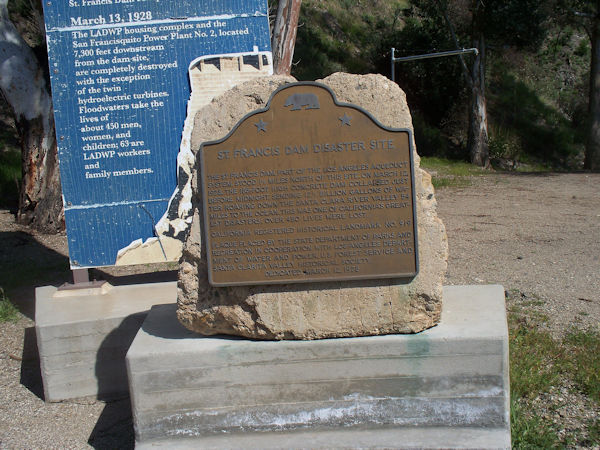SEJournal Online is the digital news magazine of the Society of Environmental Journalists. Learn more about SEJournal Online, including submission, subscription and advertising information.
 |
 |
| A plaque commemorating the site of the 1928 St. Francis Dam disaster in Los Angeles County, California. Photo: Konrad Summers, Flickr Creative Commons (CC BY-SA 2.0). |
WatchDog Opinion: Dam Secrecy Exposes Public to Dam Disasters
By Joseph A. Davis
In 1928, the St. Francis Dam, built two years earlier to feed the thirst of Los Angeles, failed catastrophically, killing at least 431 people. The cause was bad construction and hubris. Not terrorism.
A documentary on the disaster, “Flood in the Desert,” was broadcast on May 3, 2022 by PBS. On May 5, the Associated Press published a feature package warning, in essence, that such a thing could happen again.
The headline was that the number of potentially lethal U.S. dams in poor condition is actually growing. But not enough attention was paid to the sidebar in the AP package, headlined “Condition of some US dams kept secret in national database.” The sad thing is that that wasn’t news.
The full potential for dam disasters has been kept secret
by both state and federal agencies, who have justified
the secrecy by invoking terrorism. But that’s malarkey.
Since well before the 9/11 terrorist attack on the U.S., the full potential for dam disasters has been kept secret by both state and federal agencies, who have justified the secrecy by invoking terrorism. But that’s malarkey.
We need more warnings — not less. And delivering them is the job of journalism. If history is a guide, journalists can’t expect much help from public safety officials.
The many causes for recent dam failures
Scores of dams have failed in the last two decades. The failures were caused by climate-driven floods, by owner abandonment, by neglected maintenance, by procrastination on repairs, by bad engineering, by shoddy construction, by geological ignorance, by seismic instability, by old age, by financial greed, by lax regulation, by government budget shortfalls, by political pressure and more.
None of the dam failures in the past two decades have been caused by terrorism. Arguably, some of them have been caused by a lack of public attention to dam safety issues.
First, the good news. The National Inventory of Dams, or NID, which is maintained by the Army Corps of Engineers, has made some partial steps toward less secrecy in a recent upgrade. We salute them.
But the bad news is that safety problems are getting worse. The problem is not terrorism. It’s development and aging.
As areas downstream of major dams fill in with the construction of more housing and businesses, the risks of death and damage from a dam failure increase. And as the years go by, the concrete of even the strongest dams may weaken. Not all dams are made of concrete, and water takes a toll.
Dam condition reports not always publicly available
Until quite recently, the public (and journalists) could not even get the “hazard potential classification” of dams in the NID. That rating means a failure would cause death downstream (high hazard) or destroy property (significant hazard).
For high-hazard dams, it is important to know what condition they are in. If they are crumbling or being undermined by water, failure is a big risk.
High-hazard dams are supposed to have “emergency
action plans,” but not all do — and sometimes
these are not disclosed to the public either.
Engineers are supposed to inspect dams on a regular schedule — but the results (dam condition reports) are not always available to the public. High-hazard dams are supposed to have “emergency action plans,” but not all do — and sometimes these are not disclosed to the public either.
The disclosure of dam safety information is complicated by a jurisdictional jigsaw puzzle. The vast majority of the 90,000-plus dams in the NID are privately owned and regulated by state agencies. Every state is different: some are lax and some do not disclose dam condition reports. Furthermore, the situation is different for federally owned and state-owned dams.
Worse yet, there are some 18 federal agencies that may own and operate dams. The biggest are well-known, like the Corps and the Bureau of Reclamation, but many others are on land managed by the Forest Service, the Bureau of Indian Affairs and other agencies. When a dam (public or private) is used for hydropower, it is regulated by the Federal Energy Regulatory Commission.
So even though the NID may prefer to list dam safety info when available, a lot still isn’t available because it is kept secret by the state or federal agency.
Overcoming government secrecy with coverage
The AP team — David A. Lieb, Michael Casey, Michelle Minkoff and others — deserve an extra round of applause for shoe-leather reporting beyond the NID. They actually filed Freedom of Information Act requests with each state or agency to get any info not in the NID, along with other reporting. You may remember this was an update of a similar package they did in 2019.
The good news is that more money has been budgeted by governments in recent years. Some of that, around $3 billion, has come via the Biden administration’s post-COVID infrastructure spending legislation.
But we should not lose sight of the fact that a lot more dam safety spending has followed from the AP’s original expose in 2019 — or the spate of coverage that followed the Oroville Dam crisis of 2017. (In that incident, 180,000 people were evacuated even as California refused to give the public full information about the dam’s threat.)
The bad news is that even these spending increases are not enough to keep the public safe. The answer may be overcoming government secrecy with even more coverage. And more disclosure.
Joseph A. Davis is a freelance writer/editor in Washington, D.C. who has been writing about the environment since 1976. He writes SEJournal Online's TipSheet, Reporter's Toolbox and Issue Backgrounder, and curates SEJ's weekday news headlines service EJToday and @EJTodayNews. Davis also directs SEJ's Freedom of Information Project and writes the WatchDog opinion column.
* From the weekly news magazine SEJournal Online, Vol. 7, No. 22. Content from each new issue of SEJournal Online is available to the public via the SEJournal Online main page. Subscribe to the e-newsletter here. And see past issues of the SEJournal archived here.












 Advertisement
Advertisement 



